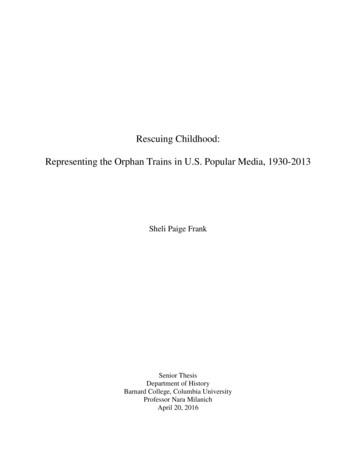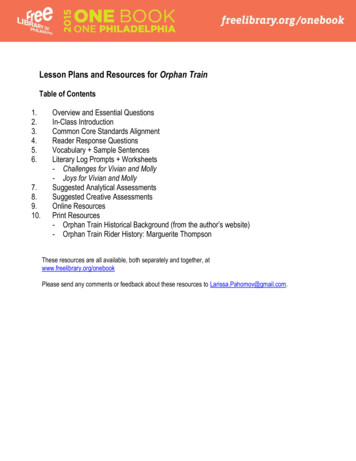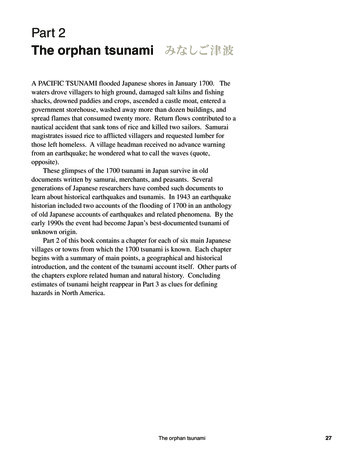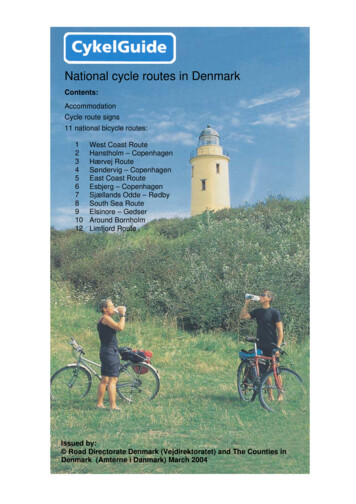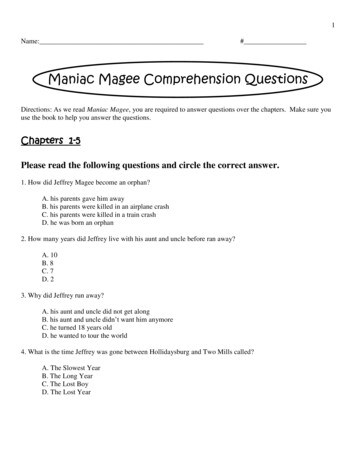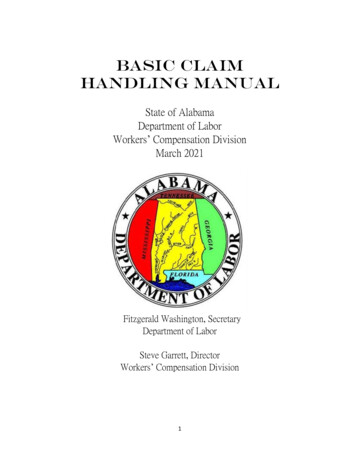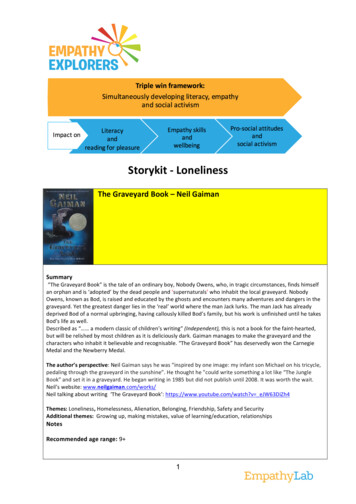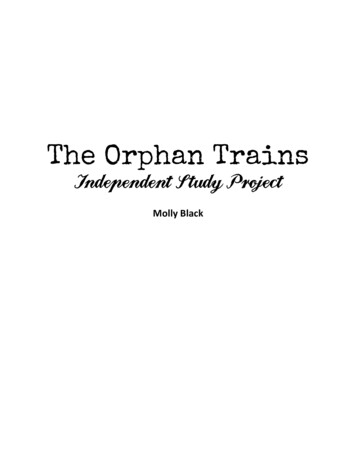
Transcription
The Orphan TrainsIndependent S tudy ProjectMolly Black
Project ProposalHistorical Event:a) For my independent study project I will be studying the Orphan Trains. The Orphan Trainsran from the 1850s to the 1920s and transported abandoned and orphaned children on theEast Coast to the West, where they were adopted and could start a new life. It was relatedto immigration, and left a large impact on adoption in the United States.b) I chose this event because I am very interested in adoption, and the Orphan Trains played amajor role in the current adoption system.c) Research Questions:(1) What are the different perspectives of the individuals whose lives were impacted bythe Orphan Trains? (Children on the trains, people adopting the orphans, peopleadministering the orphan trains, outsiders)(2) How did immigration impact the number of orphans and abandoned children on theEast Coast?(3) How did the Orphan Trains shape the foster care system and adoption system inAmerica?(4) Were the Orphan Trains justified?(5) Were the Orphan Trains created out of self interest or the common good?(6) What are children’s rights?d) My study of the Orphan Trains relates to class this year, because it looks at US Historythrough many perspectives, justice, and the civil rights of children.Reading List- Include the title, author and a brief summary of:a) Fiction Novel:(1) My Heart Remembers; Kim Vogel Sawyer. “Maelle Gallagher and her little brother, Mattie and babysister, Molly have just been orphaned in a tenement fire. As recent immigrants from Ireland, they're put on an"orphan train" and sent west to Missouri to find new parents and a new home. As the oldest, Maelle had beencharged by her father to "look after the wee ones." Maelle does her best, but her little siblings are literally tornfrom her arms by the separate families who adopt them. But Maelle will never forget them and will never stopsearching for the only family she has ever known.”b) Film: The orphan trains [videorecording] / produced and directed by Janet Graham andEdward Gray ; written by Edward Gray. Available at Durango Public Libraryc) Articles(1) Children’s Aid Society 1854 Annual Report: This is the first report put out by theChildren's Aid Society. The reports usually contained business information,treasurer's report, and letters written to the society by the children or theirguardians. This article contains 9 pages from the 1854 Report of these such AidSociety1854AnnualReport1.html)(2) How it all began: A history of how the orphan trains came to html)(3) How the Orphan Trains shaped Adoption History:(a) Summary ml
(b) Historical Explanation “Placing cingout.html(c) Historical Explanation “Charles Loring race.html(d) Historical Explanation “Bertha and Harry lt.htm(e) Historical Explanation “International le/holt.htm(f) Ridersa. Marguerite Thompson: Orphan Train rider who was treated like ry.htmlb. Irma Craig: Was treated as an equal, happy with her ory.htmlOther Resources:a) Adoption Flyers for Orphan Train Children: Flyers such as this would be sent to each townbefore the children arrived on the orphan train. This way, the townspeople would know thechildren were coming and could be at the designated place to adopted tml)b) Map: Number of Children Placed Out from 1854- 1910.http://www.orphantraindepot.com/Map.htmlc) http://www.orphantraindepot.com
Project ProposalWere the orphan trains justified?The orphan trains were justified due to the immense amount of need and horrible living conditions ofchildren on the east coast during the 1850s.In the 1850s, Charles Loring Brace recognized the hugeamount of need around him, and how many children were living orphaned, hungry, and homeless onthe streets. His response to this recognition is what some now call "evangelical humanitarianism." Bracewanted to respond to all of the need on the west coast in a way that was effective and had a positiveimpact on the childrens' futures. Thus, the orphan train era was born. Brace told the heartbreakingstories of children he met in New York City, struggling to make it through each day. Overpopulation dueto immigration left thousands roaming the cities. Controlling the homeless became such a big issue thatchildren as young as five were being put in jail, so that they would no longer be crowding the streets.The way that Brace worked to resolve this problem was to "salvage the civic potential of poor immigrantchildren by placing them in culturally "worthy" families while simultaneously reducing urban povertyand crime and supplying some of the workers that western development required." Brace was confidentthat the system he developed would give children a chance, and provide new opportunities for eachchild. Unfortunately, many children had bad experiences with families and were treated poorly. While theorphan train system was in need of refinement, the means justify the ends. The means of organizing theorphan trains and working to create a better way of controlling homeless children, and working to givethem a chance, justify the fact that some orphan train riders had bad experiences in their new homes. Ifnothing else, there is justice in Brace working to create a better system, and not just being a bystanderto the obvious need of children in the 1850s.How did the orphan trains shape the foster care and adoption system?The orphan trains had a large influence on the current foster care and adoption system in the UnitedStates. During the 1900s, there was a large shift from institutional care to adoption, and placing childrenin families. The orphan trains were the catalyst to this shift. The orphan trains and the philosophy ofchild rescue highlighted nurture over nature, like adoption and foster care. In 1909, at the White Houseconference on Children, home life was deemed "the highest and finest product of civilization." Thispromoted the idea of nurture, and the idea became more widely accepted, and by the 1960s,institutional care began to decline. Because Charles Loring Brace began the highly controversial orphantrains, putting children in families instead of leaving them on the streets, or placing them in anorphanage became more popular and widely accepted. Today, we commonly accept adoption, butbefore Charles Loring Brace, it was considered "child-stealing" and frowned upon. Because hepersevered with the orphan trains, and pushing forth with adoption, it is now commonly accepted andshaped the adoption and foster care system we now have in place.What are the different perspectives of the people whose lives were impacted by theorphan trains? (Children on the trains, people adopting the children, peopleadministering orphan trains)Many people's lives were impacted by the orphan trains, and many lives still are. Many of the childrenon the orphan trains thought of the orphan trains as an opportunity. They were told it would give thema chance at life- a new beginning. People like Maelle in my fiction book "My Heart Remembers," had
their perspectives shift after being adopted, and realized that the orphan trains hadn't cultivatedopportunity, but hindered it by splitting up families and limiting children to their new family'sexpectations. Riders like Irma Craig had a different perspective, and saw the orphan trains as a blessingbecause of the love in the new families they were in. Some people adopted children on the orphantrains because they needed someone to work for them or carry on their business. Some people adoptedbecause they saw the children in need and wanted to help them, while some people's intentions werefar less than loving. Charles Loring Brace and the people administering the orphan trains had goodintentions, and wanted to help all of the children on the streets of the East Coast. For them, there was aneed that they felt called to meet, and the orphan trains were an efficient, effective solution. Ultimately,because this was a controversial issue, and there were such a wide variety of perspectives based oneach individual person, this question is hard to answer in a general way. What I did find through myresearch is that no two people had the same experience, and what a wide variety of perspectives therewere between people.
Documentation:My Heart RemembersNovelMy Heart Remembers is a book about three Irish Immigrant siblings who are orphaned when theirapartment building catches on fire. They are taken from New York City to Missouri on an orphan train,where each is taken from a different family. The story fast forwards through their life, and follows theirsearch to find each other. It talks about people fighting for Child Labor Laws, and the joys and pains ofthe siblings’ lives apart. After seventeen years of searching for each other, the siblings are reunited.This book was hard to read at parts, because it depicts the struggles that orphaned children in the 1880sand 1900s encountered. It was sad to hear the stories of the pain that each child faced. At the beginningof the book, the children were told that they were fortunate to be getting a fresh start, and newopportunities, when little of that turned out to be true. Parts of this book were encouraging and happy,but there were parts of sadness as well. As expected, parts of this book were somewhat cheesy, and Ithink that parts were unrealistic, such as the reuniting of all the siblings in the same town. While thismade for a better plot line and “happily ever after,” I don’t think it was probably the case for a lot of theorphan train riders who were separated from their families.In the midst of this, this book did spark some questions for me. These include: How did the intentions ofpeople wanting to adopt orphan train children vary? Did this have an impact on the treatment of thechild? How do you hold on to your old life while learning a new way of life? How were children seenduring this time period? What are some of the main causes of being orphaned during this time period?Did the orphan trains actually give children “a chance at life?” How did children stay grounded andsecure when things were constantly changing?I made a few personal and outside connections to this book, one of which was on page 45, which says:“But Maelle held back, clutching Matties’s sweaty hand. ‘Me ma would not approve of us goin’ into aplace where spirits is sold.’” In this case, Maelle has a dilemma, as she was caught between the moralsof her birth mother, and obeying her surrogate father. I can connect to this personally, as I have done alot of traveling, and when I go to a new place, it can be really hard to figure out how to balance whatyou know, and what is happening in the new environment. Another connection I made to this book wasthe children's lack of rights and lack of say in anything that happened. In Larry Watson's book, Montana1948, the whites are the ones in control, the law enforcers, and they can do whatever they want to theIndians and get away with it. In this book, the adults also took this authority, by making the executivedecision that the children being sent to the West was the "right" thing to do. The children had no say inwhat was best for them, and so the adults could get away with doing anything, good or bad, much likewhat happened in Montana, 1948.
Documentation:The Orphan TrainsDocumentaryThe Orphan Trains is a documentary that contains interviews with orphan train riders, letters, photosand videos that capture the essence of the Orphan Trains. This movie describes the joys and happinessof riders, but also the loneliness and struggles they faced.I didn't expect this movie to be as sad and hard to watch as it was. It made the orphan trains so muchmore real, because it was told by the riders themselves. You truly experienced the joys and pains thatthe children felt as they were taken west. There were testimonies of children treated like slaves andaliens- not accepted by anyone else. There were also stories of joy- like that of one little girl, whoseadopted father told her he would never beat her; or the boy whose adopted father told him he wouldbuy him a pony and a bicycle. The audience of this film really shares in their happiness and frustration.One thing that stuck out to me was when they talked about how the homeless population on the eastcoast was trying to be controlled. One method of trying to control all of these homeless people and getrid of them was to put them in jail. The movie said that kids as young as five were being thrown into jailbecause they had no home. It broke my heart to hear this, because it puts in perspective the need forsomething better. It was so hard to hear about the suffering these children had in the city. At the sametime, to make them leave behind all that they have ever known is a hard transition. I think that thismovie did a good job of balancing the perspective of those helped and hurt by the orphan trains, andgave a good depiction of what it was truly like to be an orphan train rider.In the midst of this, this book did spark some questions for me. These include: What were the sources ofstrength and hope for the orphan train riders? Should children have a say in who their adopted parentsare? Would there have been a better alternative to the orphan trains?While a somewhat crude connection, I think that the orphan train riders' stories can be connected toanimals in an animal shelter. The riders of the orphan trains are like the animals- lost and without ahome, and in need of somewhere to go. The animal patrol pick these animals up with the intention ofhelping them and taking them to a place where they will be cared for. The small metal kennels theanimals are put in are often less than ideal, but are theoretically better than just being on the streetslike the children were. When people want to adopt the animals, they go into the shelter, and pick a cator dog they like. Typically the cuter kittens get picked before the older cats. To take your animal home,you just have to pay a fee, and you don't really have to commit to "loving" and "nurturing" the animal.Naturally, some animals are taken to good homes where they are well cared for and treated kindly, andsome are taken to homes where they aren't taken care of. A lot of the orphan train riders experiencedthe same things- the cute and happy kids get picked first. The people adopting didn't have to commit toactually love the orphans, they just had to feed them, clothe them etc. until a certain age. As this filmexpressed, some children were taken to better homes than others, and they didn't have any say as towhere they were going. While a crude example, I think it is a good representation of the variety ofstories this film expressed.
Documentation:How it All BeganNon-Fiction ArticleThese two nonfiction articles explained the importance as well as the story behind the Orphan Trains. Inthe Children's Aid Society 1854 Report, Charles Loring Brace, Founder of the Orphan Trains writes thestories of children on the streets. He explains the immense need and awful conditions that existed forthousands of children. There are stories of children in prison, children who chew on bones for food, andwho had no one to care for them. The article "How it All Began," explains that these conditions weredue to places like New York City being " 'boiling pot[s]' of chaotic living, conditions with widespreaddisease, crime, breakdown of family life, and innocent children suffering." There were hundreds ofthousands of immigrants, which resulted in thousands of children living in awful conditions.In the Children's Aid Society (CAS) Report, pathos was used to appeal to the emotional side of theaudience. The stories of children on the streets made for a sad story, with children who would rather bedead than be in their position. These depressing, disheartening stories This highlighted the OrphanTrains in a very positive way. This glorified the Orphan Trains so they were seen as the only hope, and anamazing idea. In this paper, these children's reactions when they were told they could have a "newstart" was amazing. While very biased, this article helped me to see the orphan trains as more justified.In this article, you can see the need Charles Loring Brace saw in the 1850s, and his need to help thesethousands in some way, and in that sense, I think the orphan trains were such a great idea. While I dosee this, my main "push back" would just be the bias, and the selective stories used to portray pathos tothe audience. I don't think that all the children were this eager to leave their lives on the east coast, andprobably not all were in this strenuous of situations. I think the selectivity of the content in this article,and all the pathos used is effective, but not as credible and fact-based as the article "How it All Began."This article was a lot less biased, and gave the facts behind the beginning of the Orphan Trains.In the midst of this, this book did spark some questions for me. These include: What were the logisticslike of the Orphan trains? How was everything recorded and kept track of if thousands of children were"placed out?" Did Charles Loring Brace face any push-back from people when he was planning theorphan trains, or were they a widely-accepted idea? Of the 200,000 children who were placed out, whatwere the statistics like on their futures? Did the orphan trains achieve their goals? Did Charles LoringBrace see the Orphan Trains as a success?One connection I made to the Children's Aid Society Report was our Morality and Politics of Justiceproject in humanities. In this project, we had to use evidence to support the claim we were making, andthen use rhetorical devices in a poster in order to challenge the audience. I think that this article didthese same things. It used evidence of the children's stories in order to back up the actions of CharlesLoring Brace, and make the audience see another side of the issue. This article also challenged my ideaof what justice is, as before I saw the orphan trains as less justified than I do now. This actually changedmy perspective on the orphan trains, because I can see the need and purpose behind them. Therhetorical use of pathos in this article made it more convincing, as it was able to appeal to theaudience's emotional side, and then help them draw a logical conclusion to the orphan train solution.
Documentation:Shaping Adoption HistoryNon-Fiction ArticleThese articles described how the "evangelical humanitarianism" of the original orphan train idea shapedadoption history. They talked about the large controversy involved in this ambitious project to giveorphaned children a chance in life. The orphan trains were taken advantage of, and did not meet theoriginal orphan train goals, like permanently separating children from their former lives. These articlesalso described the shift from orphanages and institutional care to adoption, and putting children infamilies. In 1955, controversial Bertha and Harry Holt adopted 8 Korean war orphans, and continued thisevangelical humanitarianism by helping other families to adopt internationally. Like Brace, theirintentions were formed out of faith and altruism, but their actions remained controversial. The Holtsbelieved that "love was enough to make the families that children needed," like Brace, and both pavedthe way for our current adoption and foster care system.These articles were very interesting to read, and observe the shift from institutional care to adoptions. Iwas inspired by Bertha and Harry Holt and how they were pioneers of international adoptions. I wastouched by their story and their motivation to make the international adoption system more accessibleto people in the United States. As someone who wants to adopt, I think that their work is reallyinspiring. While they did make it easier to adopt, I do think that it is important to have structure inadoptions, in order to make sure that children are going to good homes, and so the legal part ofadoption is worked out better.Some questions that this article presented were: Is love enough to make a family? Does belonging havea color or a nation? Some questions that arose as I was reading this were: What were the benefits ofchildren staying in orphanages? Which is more important, nurture or nature? In what ways is there stillfear of adopted children?One connection that I made to these articles were to something close to my heart. Actually, were somechildren close to my heart. At this past Thanksgiving, I had the opportunity to spend time with two of mycousins who were adopted in the past few years. Fear has always been prevalent in the adoptionprocess, and I think that as we have progressed, fears have begun to disintegrate, in things like eugenicsand fear of judgment. One article posed the question: Is love enough to make a family? I don't love mycousins any less because they are adopted, and I think they belong just perfectly in my family. I am sothankful for the progression of the adoption system, because instead of being put in orphanages, mycousins were given families, and I see that as a huge blessing. The adoption process has been shaped bymany things, and without it, I would not have Isaac and Sydney in my life.
Documentation:Other PerspectivesPrimary SourcesFor my primary sources, I examined 3 documents. One was the story of Marguerite Thompson, a girlwho rode the orphan trains and suffered abuse, and was treated unfairly in her new home. The secondstory I read was the story of Irma Craig, a girl who enjoyed her new home, was treated nicely andappreciated the orphan train opportunity. The third document I examined was the flyer that was put uparound towns that the orphan trains visited. This flyer listed the requirements for adopting a child(which were few) and used the rhetorical technique of pathos to try and convince people to adopt.One thing that I thought was really interesting in all of these documents was the idea of "love." IrmaCraig said, "we were poor but we didn't know it because there was plenty of love in our family to goaround." In Marguerite's story, I found that there was a lack of love for her in her family, and she wastreated poorly and was treated as a lesser person. She lacked the love that Irma experienced in her newhome. In the flyer, the requirements for adopting were that: children must be treated as members ofthe family, be sent to school, church, Sabbath school and be clothed until the age of 17. Yet nothing waslisted about loving the children, which I think is crucial to adopting a child. Really, the differencebetween Irma and Marguerite's stories was love, and I found it so sad that children would be taken intofamilies who didn't love them. As someone who loves children and who is passionate about adoption, Ican't fathom this lack of love for a child. Unfortunately, many children were not taken in to be loved, butto be workers, or to do a job- not because their new family loved them.The questions these documents sparked in me were: Why didn't people love the children they adopted?How does the current adoption system make sure, or does it, make sure that the parents adopting willlove their children? What regulations and requirements are now in place? Does the current adoptionsystem still use rhetoric?One connection that I made to the story of Marguerite Thompson and her lack of acceptance in her newfamily to our recent project in Spanish. For hundreds of years, we have called Mexican immigrants"Mexican-Americans," just like Marguerite took her family's name, but we have not treated them asAmericans. There is an immense amount of inequality between Mexican immigrants and whiteAmericans, like between Marguerite and the rest of her family. Marguerite explains that there were tenbedrooms in her new house, but she was told to sleep on a mattress that her family kept in the closet.Like Marguerite, America has plenty of room for Mexican-Americans, plenty of room for acceptance andthey are not treated as a part of the family. We invite them into our country like Marguerite was invitedinto the home, and then treat them horribly, unequally, and like they are lesser than us.
orphan train system was in need of refinement, the means justify the ends. The means of organizing the orphan trains and working to create a better way of controlling homeless children, and working to give them a chance, justify the fact that some orphan train
